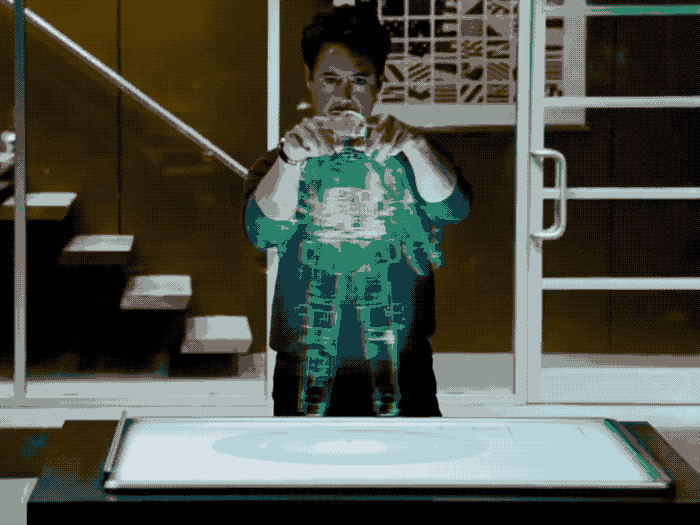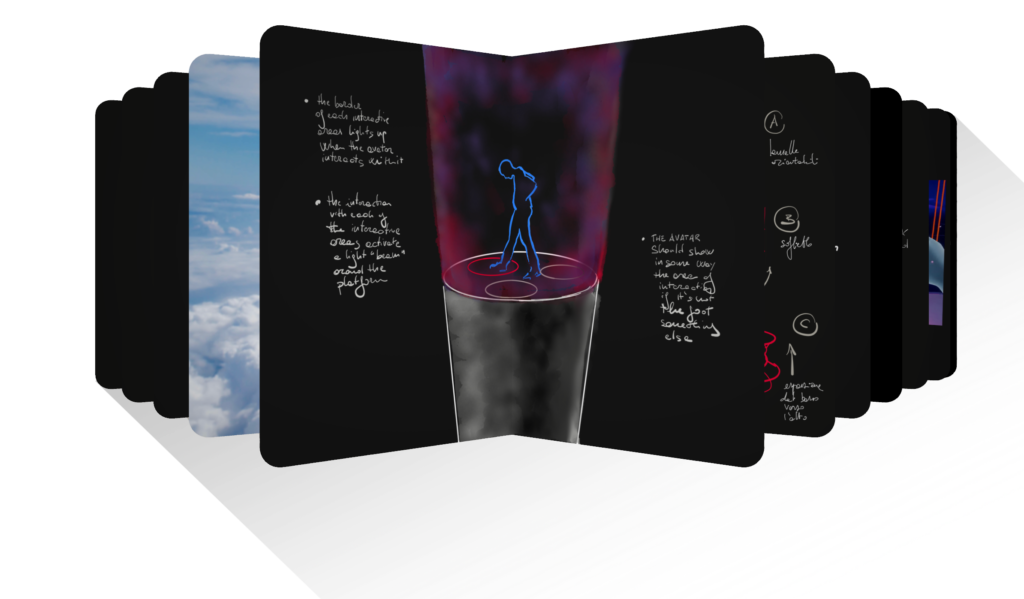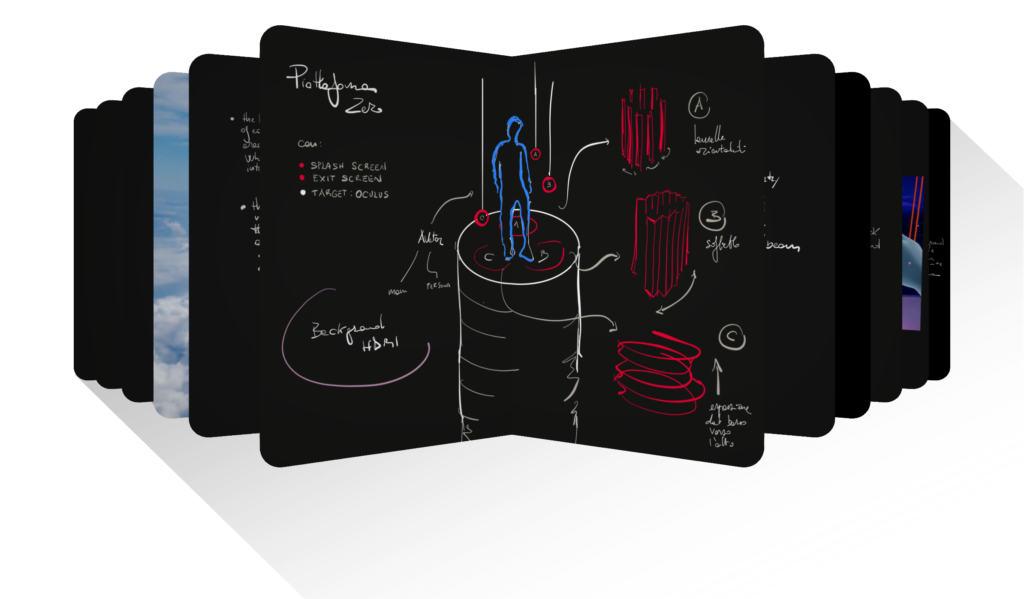Everything started with a simple exercise:
“[…] please build a basic 3D game experience with a 2100 mm diameter circular platform suspended in a vacuum. On this platform identify three circular areas of 600mm diameter each, which we will call A, B and C. Rules of the game: the player is free to move on the platform, each of the three circular areas is interactive; each interaction is activated with the presence of the player above the area itself; each interaction triggers an event […]”
That’s what we asked all the aspiring T.E.A.M. project participants. This 3D experience later evolved, becoming the “Piattaforma Zero”: our very first act in the study and research for the representation and manipulation of mathematically correct dynamic design elements in Virtual Reality.
First, a small step back
You’ve probably seen that part in Iron Man when Tony Stark designs his armor in the open air using a system presented as a mix of augmented reality and voice-controlled AI. That remains, as of today, a plausible yet futuristic sci-fi representation. In fact, there’s no software yet able to give that extraordinary freedom of manipulating a design idea.
When, with a digital tool, you design something that will finally be a real object or architecture, more often than not you have to adapt your brain to work as the system does. Even if the designers and engineers who created the software did an extraordinary job building a user interface that honors and also supercharges how the human brain works, you’re still stuck representing 3D objects on a bi-dimensional media – your display. You’re still seeing a perspective representation of space: you’re not immersed in it.

Mostly in our western culture, we have developed a method of creating “things” by dividing the representation of our projects into two specific acts: first designing on paper and then building scaled-down models of the final design. We need the “technical” drawing in order to understand and to explain to other people all the parts and details of the project idea and the 3D model – or a perspective representation of it – to figure out its shape and to see and show to others how it could be perceived in “real space”.
We believe that AR and VR technologies – not to mention AI – could completely revolutionize this process, opening a world of possibilities to think and create things that simply cannot be created with today’s tools.
Don’t get me wrong, interesting apps already exist today that allow for people to create freely in the VR environment – i.e. Google Tilt brush, Gravity Sketch, Quill, etc. Perhaps the outputs of these tools – similar but intended for different purposes – return a model that does not retain reusable geometric information that can be totally manipulated retrospectively. In other words, they return a shape without giving access to the “DNA” that generated it. Eventually, we would not only like to have continuous access to this DNA but also to create dynamic relationships between the various chains that compose our designs. All of this using only our bare hands in the free space in front of us.
User experience building blocks
One of the reasons why we decided to start with the Piattaforma Zero was to focus on the interaction in the VR environment between the user’s body and the simulated space. In this sense, the platform has been a fundamental instrument to test not only the hardware/software toolbox but also to develop these types of interactions using a trial and error approach. Starting from the considerations previously introduced, we came to define four main aspects that, intimately related to each other, would characterize the overall experience:
Correspondence between the physical and virtual space
The physical space in which the user is located must necessarily correspond with the virtual space. Hence, the idea of a circular platform coinciding with the minimum area that the user may be able to dedicate to the VR experience in his house.
Reliable interactions of the perceived volume of the user’s body
With the technology available to date, it’s not possible to reconstruct the entire body of the user in VR, only the position of the head and hands can be precisely tracked [1]. The purpose of the Piattaforma Zero is also to experience the particular implications given by moving in VR with a body that resides in space while not being visible.
Freehand interactions with virtual objects: no controllers
We have preferred to put aside completely the controllers and let the user operate in the virtual environment only with their hands. This approach has complicated the setup phase of the experience a lot but it gives us back that freedom and naturalness in VR, which for us is essential.
No desktop-like UI
We have decided to abandon any possible reference to the user interfaces that our computers have accustomed us to. So, no icons and pictograms, no menus, no cursors, no typewriter-style text fields and no files, in other worlds, no “desktop PC style” anything. Yes to the natural interactions that the physical world has accustomed us to since birth. Yes to the superpowers that digital technology can give us if used as an augmentation layer of the physical world.

Our first set of kinetic geometries
We will get down to the nitty-gritty details later regarding the creation of the first set of dynamic geometries. We are using these on the Piattaforma Zero as a virtual testing laboratory for a better understanding of the relationship between a moving architecture and the user who experiences it. Suffice it to say for now that three kinetic geometries that we initially created are an epitome, a compendium of the very idea of dynamism applied to a basic structure that can be perceived as architecture:
A sunshade because it allows you to dispense how much light to let in, as well as the amount of world that you can see through it.
A folding wall because it’s a surface that can be adjusted to different levels of concealment. It can become small, almost disappearing, or close off a space completely.
An origami because in a continuous generation of forms – each sporting a unique identity and character – it changes the perception of space.
Another story worth telling, in a future post, is about the challenge that we faced to control, in VR, a simple parameter that ends up changing the configuration of a moving structure that is fairly bigger than you. Remember: no controllers, no physical buttons, just your hands…

How and where can you see, download and try T.E.A.M.’s Piattaforma Zero and other experiences?
We will provide more detailed information about this over the next few weeks. Please keep in mind, however, that everything we are building for VR will be publicly available, as a freely downloadable app for the Oculus Quest, by the first quarter of 2021 – starting from this website.
Our opinion is that the perception of the spatial dimension is the peculiar aspect that makes virtual reality different from every other system or media – it’s the reason why we fell in love with it in the first place – hence we’re probably not going to share on this site screenshots, video or previews of the actual VR experiences that we’re building. We really believe that just seeing a 2D reproduction on a screen would be meaningless and ruin the actual experience.
That being said we can’t wait for you to try what we’re building here. Our doors are always open to anyone who wants to come and put the headset on!
John Volpato, November 9, 2020
[1] “There are systems today capable of tracking the entire body with great precision, but due to cost and complexity they’re not available in the consumer market “
Cover image
A landscape view of the Physical World from Teolo, Italy, 2020.
Photo by John Volpato.